oil pressure TOYOTA YARIS 2014 3.G Owners Manual
[x] Cancel search | Manufacturer: TOYOTA, Model Year: 2014, Model line: YARIS, Model: TOYOTA YARIS 2014 3.GPages: 400, PDF Size: 9 MB
Page 4 of 400
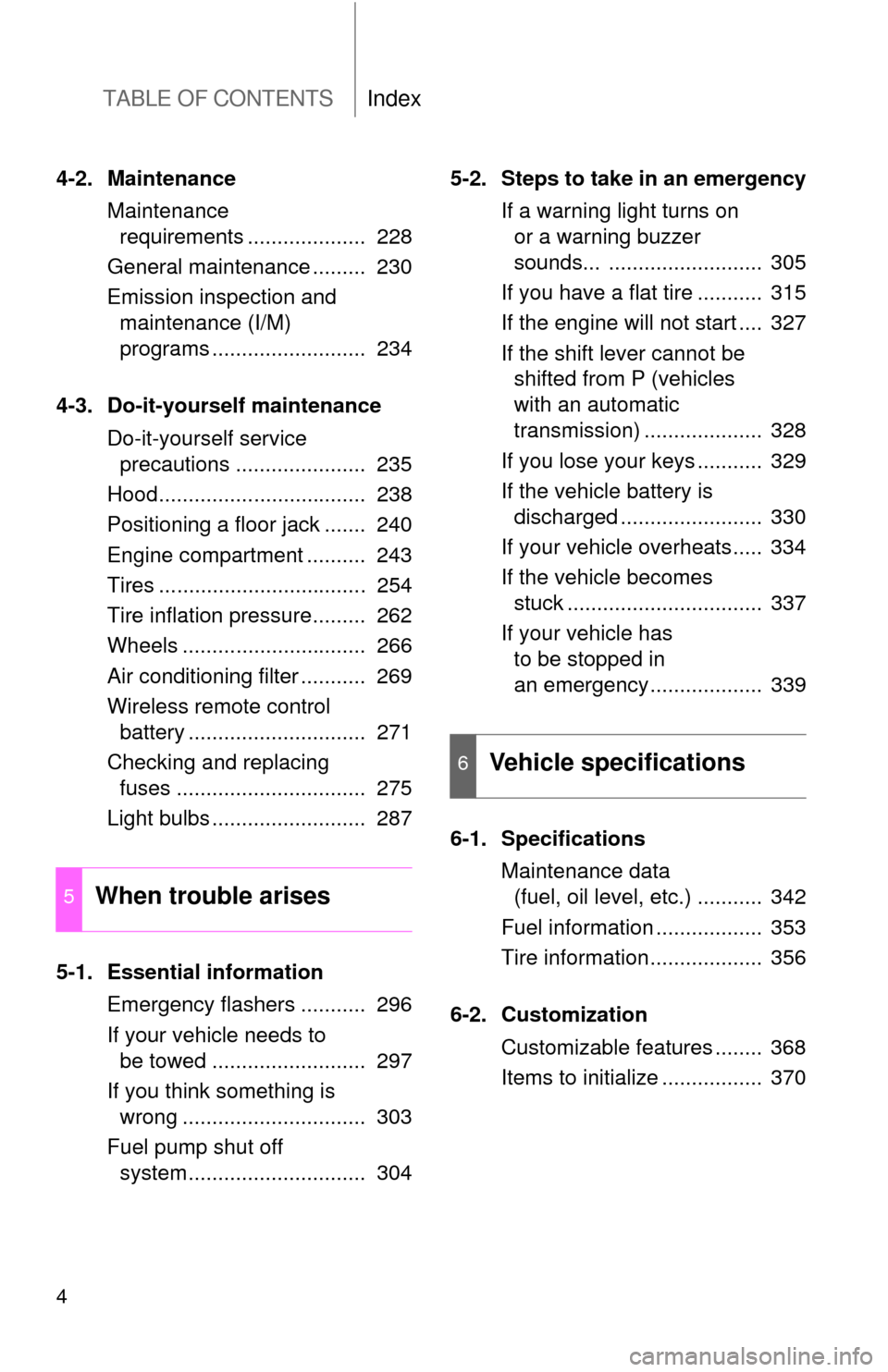
TABLE OF CONTENTSIndex
4
4-2. MaintenanceMaintenance requirements .................... 228
General maintenance ......... 230
Emission inspection and maintenance (I/M)
programs .......................... 234
4-3. Do-it-yourself maintenance Do-it-yourself service precautions ...................... 235
Hood................................... 238
Positioning a floor jack ....... 240
Engine compartment .......... 243
Tires ................................... 254
Tire inflation pressure......... 262
Wheels ............................... 266
Air conditioning filter ........... 269
Wireless remote control battery .............................. 271
Checking and replacing fuses ................................ 275
Light bulbs .......................... 287
5-1. Essential information Emergency flashers ........... 296
If your vehicle needs to be towed .......................... 297
If you think something is wrong ............................... 303
Fuel pump shut off system .............................. 304 5-2. Steps to take in an emergency
If a warning light turns on or a warning buzzer
sounds... .......................... 305
If you have a flat tire ........... 315
If the engine will not start .... 327
If the shift lever cannot be shifted from P (vehicles
with an automatic
transmission) .................... 328
If you lose your keys ........... 329
If the vehicle battery is discharged ........................ 330
If your vehicle overheats..... 334
If the vehicle becomes stuck ................................. 337
If your vehicle has to be stopped in
an emergency................... 339
6-1. Specifications Maintenance data (fuel, oil level, etc.) ........... 342
Fuel information .................. 353
Tire information................... 356
6-2. Customization Customizable features ........ 368
Items to initialize ................. 370
5When trouble arises
6Vehicle specifications
Page 222 of 400

222
4-1. Maintenance and care
Cleaning and protecting the vehicle exterior
■Automatic car washes
●Fold the mirrors and remove the antenna before washing the vehicle.
Start washing from the front of the vehicle. Make sure to re-install the
antenna and extend the mirrors before driving.
● Brushes used in automatic car washes may scratch the vehicle surface
and harm your vehicle’s paint.
● For vehicles with the rear spoiler, in certain automatic car washes, the
rear spoiler may interfere with machine operation. This may prevent the
vehicle from being cleaned properly or result in damage to the rear
spoiler.
■ High pressure car washes
●Do not allow the nozzles of the car wash to come within close proximity
of the window and door borders, and high mounted stoplight.
● Before using the car wash, check that the fuel filler door on your vehicle
is closed properly.
Perform the following to protect the vehicle and maintain it in prime
condition:
● Working from top to bottom, liber ally apply water to the vehicle
body, wheel wells and underside of the vehicle to remove any
dirt and dust.
● Wash the vehicle body using a sponge or soft cloth, such as a
chamois.
● For hard-to-remove marks, use car wash soap and rinse thor-
oughly with water.
● Wipe away any water.
● Wax the vehicle when the waterproof coating deteriorates.
If water does not bead on a clean surface, apply wax when the vehi-
cle body is cool.
Page 236 of 400
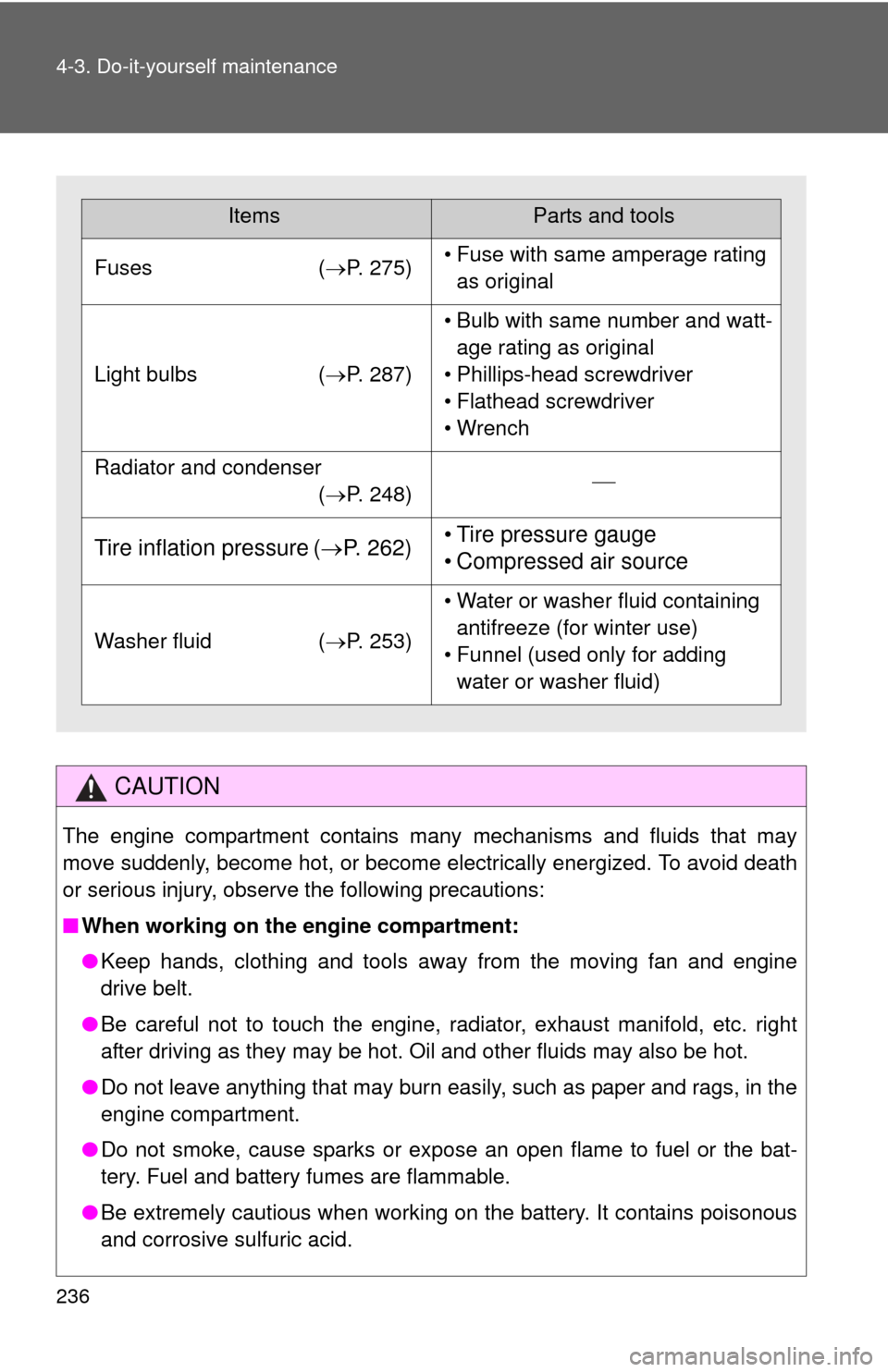
236 4-3. Do-it-yourself maintenance
CAUTION
The engine compartment contains many mechanisms and fluids that may
move suddenly, become hot, or become electrically energized. To avoid death
or serious injury, observe the following precautions:
■When working on the engine compartment:
● Keep hands, clothing and tools away from the moving fan and engine
drive belt.
● Be careful not to touch the engine, radiator, exhaust manifold, etc. right
after driving as they may be hot. Oil and other fluids may also be hot.
● Do not leave anything that may burn easily, such as paper and rags, in the
engine compartment.
● Do not smoke, cause sparks or expose an open flame to fuel or the bat-
tery. Fuel and battery fumes are flammable.
● Be extremely cautious when working on the battery. It contains poisonous
and corrosive sulfuric acid.
ItemsParts and tools
Fuses (P. 275)• Fuse with same amperage rating
as original
Light bulbs (P. 287)
• Bulb with same number and watt-
age rating as original
• Phillips-head screwdriver
• Flathead screwdriver
• Wrench
Radiator and condenser (P. 248)
Tire inflation pressure ( P. 262)• Tire pressure gauge
• Compressed air source
Washer fluid (P. 253)
• Water or washer fluid containing
antifreeze (for winter use)
• Funnel (used only for adding water or washer fluid)
Page 267 of 400
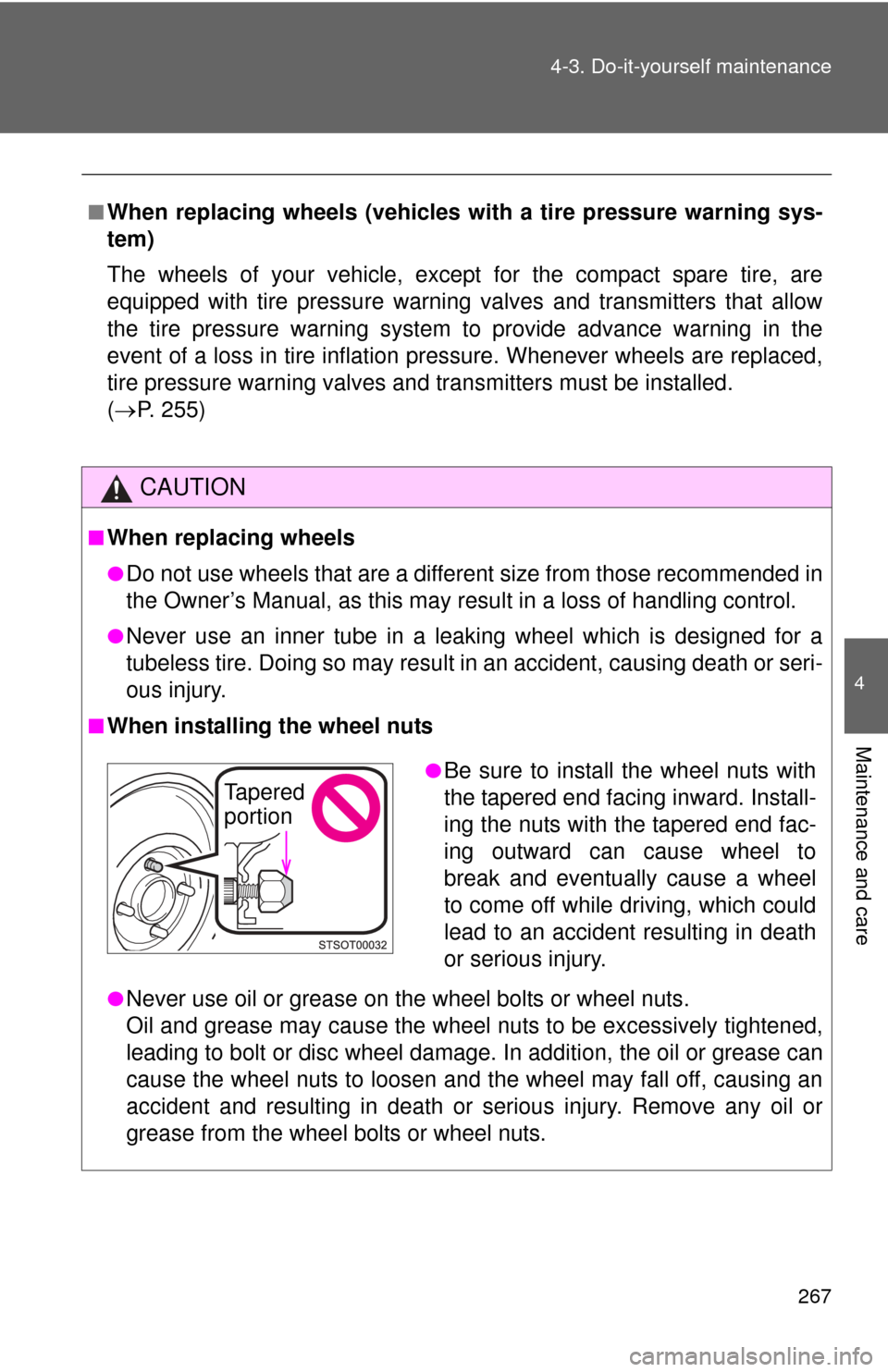
267
4-3. Do-it-yourself maintenance
4
Maintenance and care
■When replacing wheels (vehicles with a tire pressure warning sys-
tem)
The wheels of your vehicle, except for the compact spare tire, are
equipped with tire pressure warning valves and transmitters that allow
the tire pressure warning system to provide advance warning in the
event of a loss in tire inflation pressure. Whenever wheels are replaced,
tire pressure warning valves and transmitters must be installed.
(
P. 255)
CAUTION
■When replacing wheels
●Do not use wheels that are a different size from those recommended in
the Owner’s Manual, as this may resu lt in a loss of handling control.
●Never use an inner tube in a leaking wheel which is designed for a
tubeless tire. Doing so may result in an accident, causing death or seri-
ous injury.
■When installing the wheel nuts
●Never use oil or grease on the wheel bolts or wheel nuts.
Oil and grease may cause the wheel nuts to be excessively tightened,
leading to bolt or disc wheel damage. In addition, the oil or grease can
cause the wheel nuts to loosen and the wheel may fall off, causing an
accident and resulting in death or serious injury. Remove any oil or
grease from the wheel bolts or wheel nuts.
●Be sure to install the wheel nuts with
the tapered end faci ng inward. Install-
ing the nuts with the tapered end fac-
ing outward can cause wheel to
break and eventually cause a wheel
to come off while driving, which could
lead to an accident resulting in death
or serious injury.Tapered
portion
Page 306 of 400
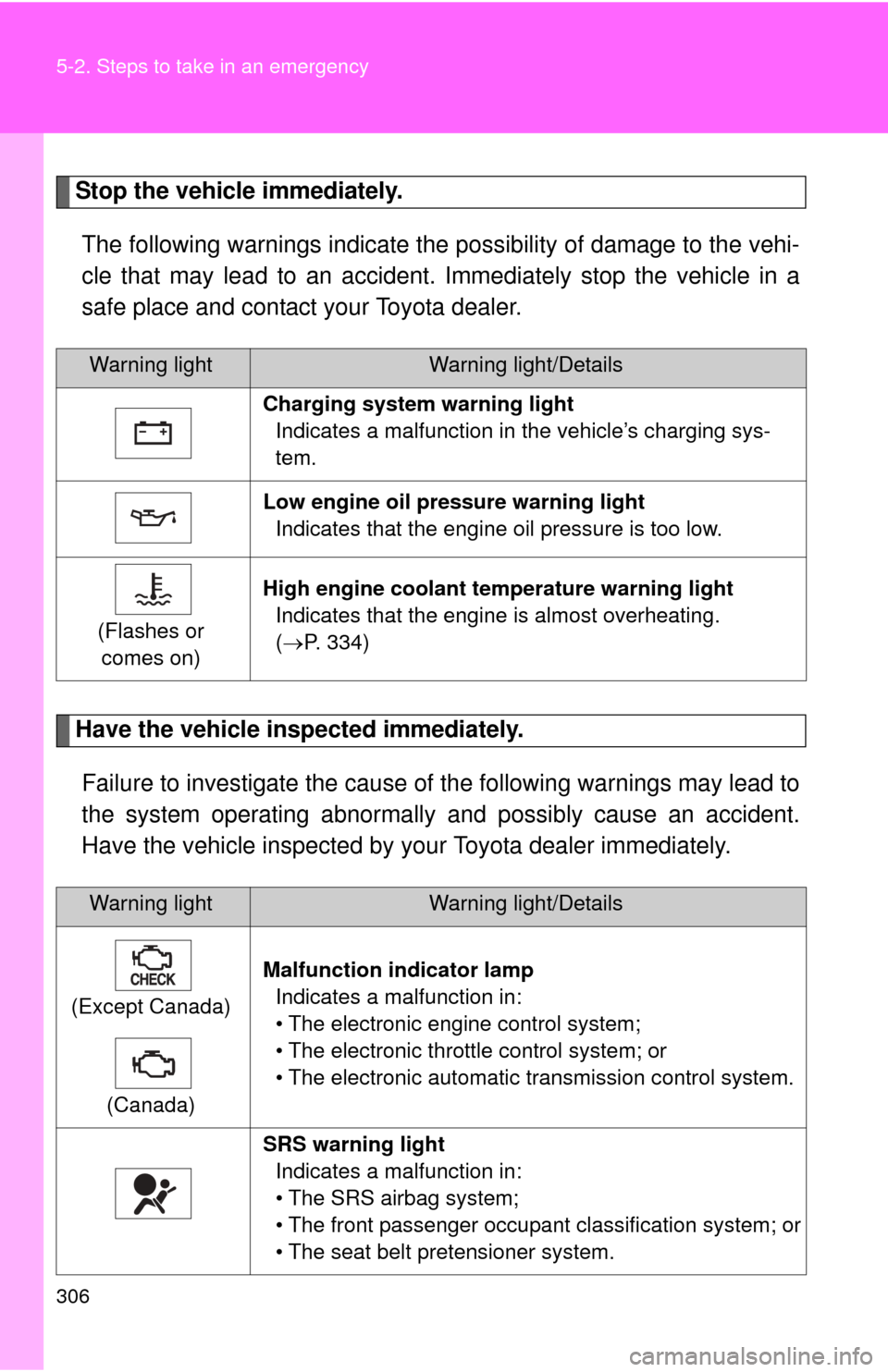
306 5-2. Steps to take in an emergency
Stop the vehicle immediately.The following warnings indicate the possibility of damage to the vehi-
cle that may lead to an accident. Immediately stop the vehicle in a
safe place and contact your Toyota dealer.
Have the vehicle inspected immediately.Failure to investigate the cause of the following warnings may lead to
the system operating abnormally and possibly cause an accident.
Have the vehicle inspected by your Toyota dealer immediately.
Warning lightWarning light/Details
Charging system warning light Indicates a malfunction in the vehicle’s charging sys-
tem.
Low engine oil pressure warning light Indicates that the engine oil pressure is too low.
(Flashes or comes on) High engine coolant temperature warning light
Indicates that the engine is almost overheating.
(P. 334)
Warning lightWarning light/Details
(Except Canada) (Canada) Malfunction indicator lamp
Indicates a malfunction in:
• The electronic engine control system;
• The electronic throttle control system; or
• The electronic automatic transmission control system.
SRS warning light Indicates a malfunction in:
• The SRS airbag system;
• The front passenger occupant classification system; or
• The seat belt pretensioner system.
Page 362 of 400
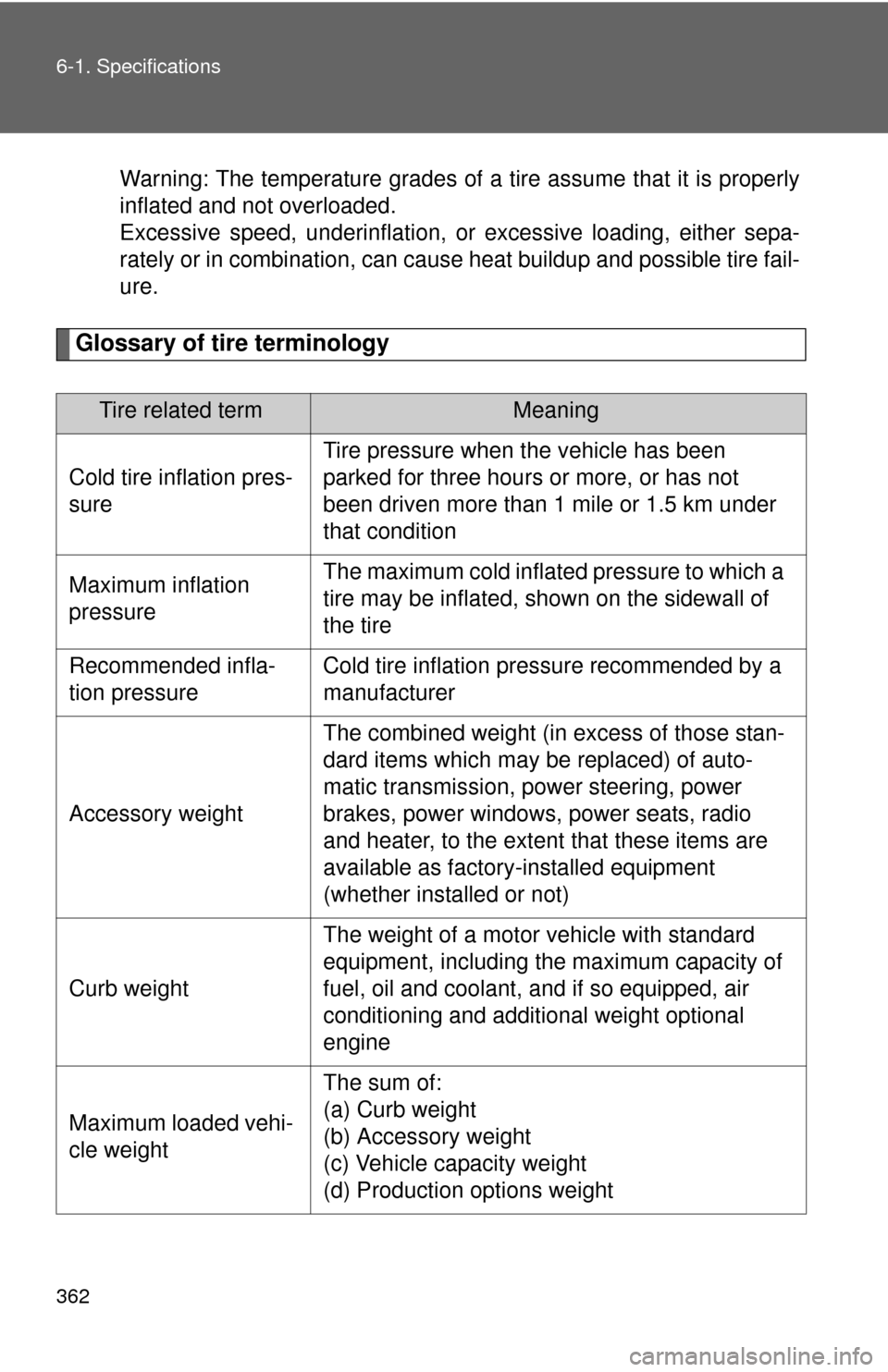
362 6-1. Specifications
Warning: The temperature grades of a tire assume that it is properly
inflated and not overloaded.
Excessive speed, underinflation, or excessive loading, either sepa-
rately or in combination, can cause heat buildup and possible tire fail-
ure.
Glossary of tire terminology
Tire related termMeaning
Cold tire inflation pres-
sure
Tire pressure when the vehicle has been
parked for three hours or more, or has not
been driven more than 1 mile or 1.5 km under
that condition
Maximum inflation
pressureThe maximum cold inflated pressure to which a
tire may be inflated, s hown on the sidewall of
the tire
Recommended infla-
tion pressureCold tire inflation pressure recommended by a
manufacturer
Accessory weight
The combined weight (in excess of those stan-
dard items which may be replaced) of auto-
matic transmission, power steering, power
brakes, power windows, power seats, radio
and heater, to the extent that these items are
available as factory-installed equipment
(whether installed or not)
Curb weight
The weight of a motor vehicle with standard
equipment, including the maximum capacity of
fuel, oil and coolant, and if so equipped, air
conditioning and additional weight optional
engine
Maximum loaded vehi-
cle weight
The sum of:
(a) Curb weight
(b) Accessory weight
(c) Vehicle capacity weight
(d) Production options weight
Page 394 of 400
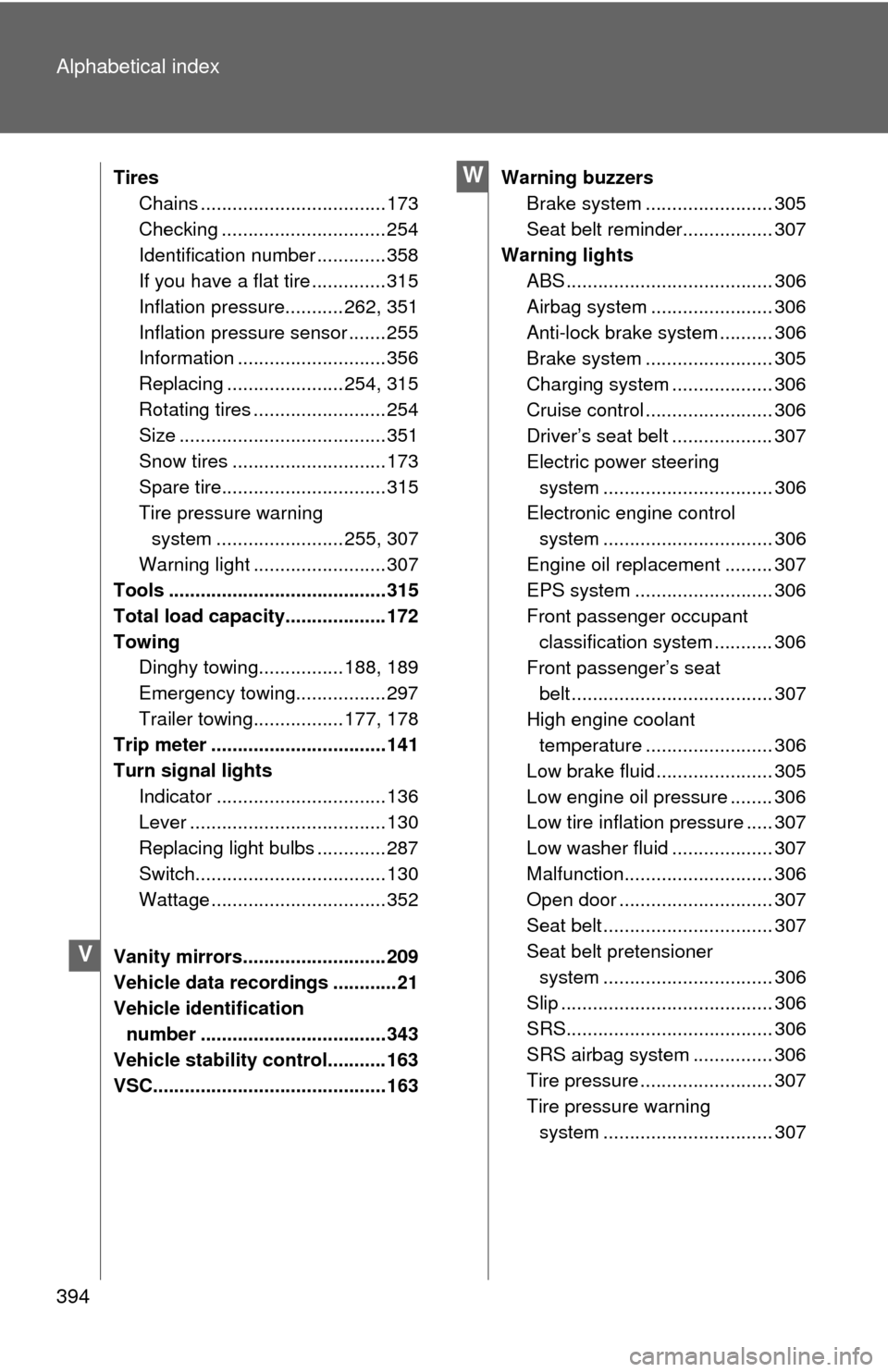
394 Alphabetical index
TiresChains ................................... 173
Checking ............................... 254
Identification number ............. 358
If you have a flat tire .............. 315
Inflation pressure........... 262, 351
Inflation pressure sensor ....... 255
Information ............................ 356
Replacing ...................... 254, 315
Rotating tires ......................... 254
Size ....................................... 351
Snow tires ............................. 173
Spare tire............................... 315
Tire pressure warning
system ........................ 255, 307
Warning light ......................... 307
Tools ......................................... 315
Total load capacity................... 172
Towing Dinghy towing................ 188, 189
Emergency towing................. 297
Trailer towing................. 177, 178
Trip meter ................................. 141
Turn signal lights
Indicator ................................ 136
Lever ..................................... 130
Replacing light bulbs ............. 287
Switch.................................... 130
Wattage ................................. 352
Vanity mirrors........................... 209
Vehicle data recordings ............21
Vehicle identification number ................................... 343
Vehicle stability control........... 163
VSC............................................ 163 Warning buzzers
Brake system ........................ 305
Seat belt reminder................. 307
Warning lights ABS ....................................... 306
Airbag system ....................... 306
Anti-lock brake system .......... 306
Brake system ........................ 305
Charging system .... ............... 306
Cruise control ........................ 306
Driver’s seat belt ................... 307
Electric power steering system ................................ 306
Electronic engine control
system ................................ 306
Engine oil replacement ......... 307
EPS system .......................... 306
Front passenger occupant classification system ........... 306
Front passenger’s seat
belt ...................................... 307
High engine coolant temperature ........................ 306
Low brake fluid ...................... 305
Low engine oil pressure ........ 306
Low tire inflation pressure ..... 307
Low washer fluid ................... 307
Malfunction............................ 306
Open door ............................. 307
Seat belt ................................ 307
Seat belt pretensioner system ................................ 306
Slip ........................................ 306
SRS....................................... 306
SRS airbag system ............... 306
Tire pressure ......................... 307
Tire pressure warning system ................................ 307
V
W
Page 398 of 400
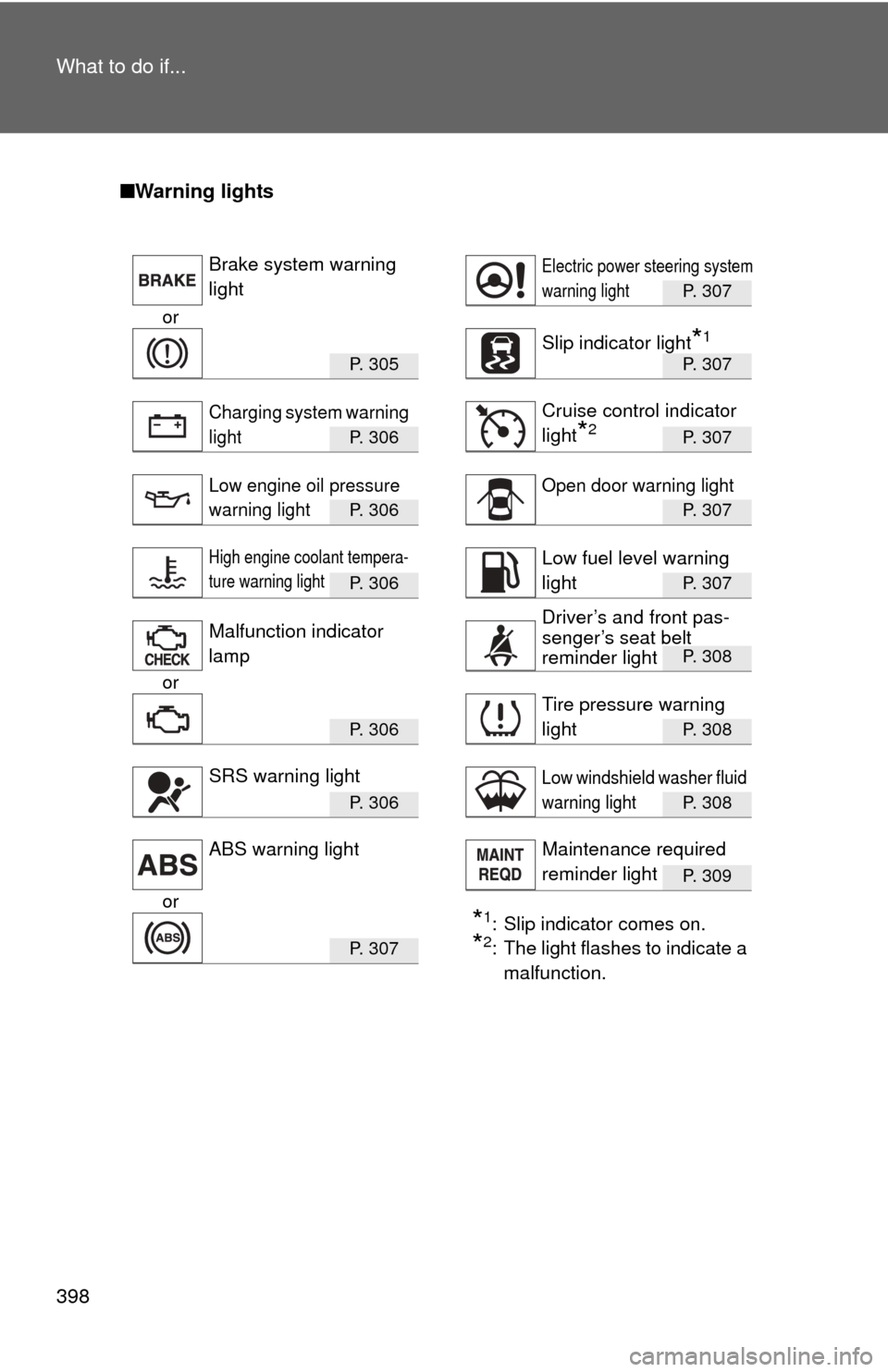
398 What to do if...
■Warning lights
P. 307
or
P. 3 0 5P. 307
P. 3 0 6P. 307
P. 3 0 6P. 307
P. 3 0 6P. 307
P. 308
or
P. 3 0 6P. 308
P. 3 0 6P. 308
P. 309
or*1: Slip indicator comes on.
*2: The light flashes to indicate a
malfunction.P. 3 0 7
Brake system warning
lightElectric power steering system
warning light
Slip indicator light*1
Charging system warning
lightCruise control indicator
light
*2
Low engine oil pressure
warning lightOpen door warning light
High engine coolant tempera-
ture warning lightLow fuel level warning
light
Malfunction indicator
lamp
Tire pressure warning
light
SRS warning lightLow windshield washer fluid
warning light
ABS warning lightMaintenance required
reminder light
Driver’s and front pas-
senger’s seat belt
reminder light
Page 400 of 400
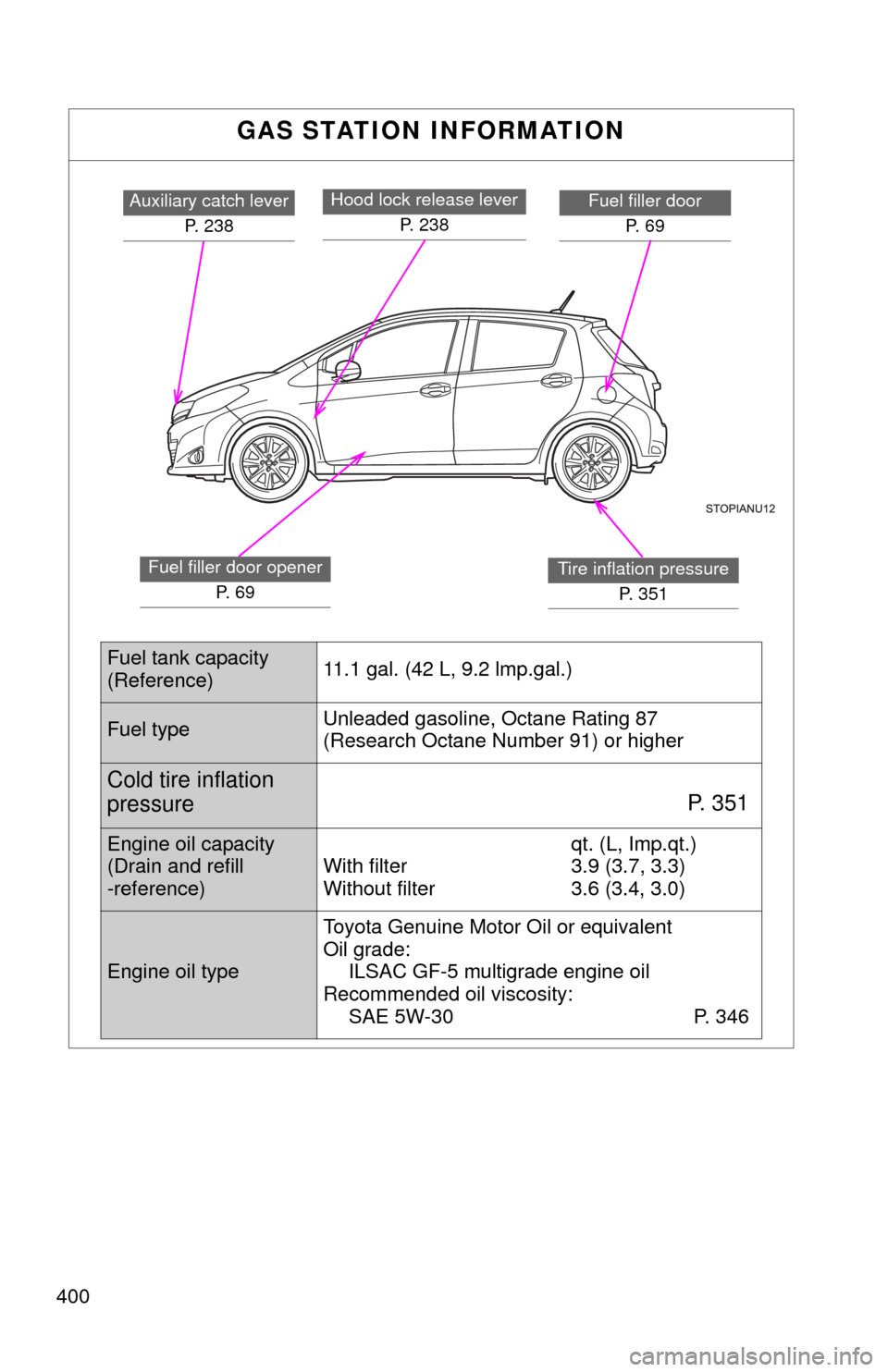
400
GAS STATION INFORMATION
Auxiliary catch leverP. 238Fuel filler doorP. 6 9Hood lock release lever P. 2 3 8
Fuel filler door openerP. 6 9Tire inflation pressureP. 351
Fuel tank capacity
(Reference) 11.1 gal. (42 L, 9.2 lmp.gal.)
Fuel type
Unleaded gasoline, Octane Rating 87
(Research Octane Number 91) or higher
Cold tire inflation
pressure
P. 3 5 1
Engine oil capacity
(Drain and refill
-reference)qt. (L, Imp.qt.)
With filter 3.9 (3.7, 3.3)
Without filter 3.6 (3.4, 3.0)
Engine oil type Toyota Genuine Motor Oil or equivalent
Oil grade:
ILSAC GF-5 multigrade engine oil
Recommended oil viscosity: SAE 5W-30 P. 346